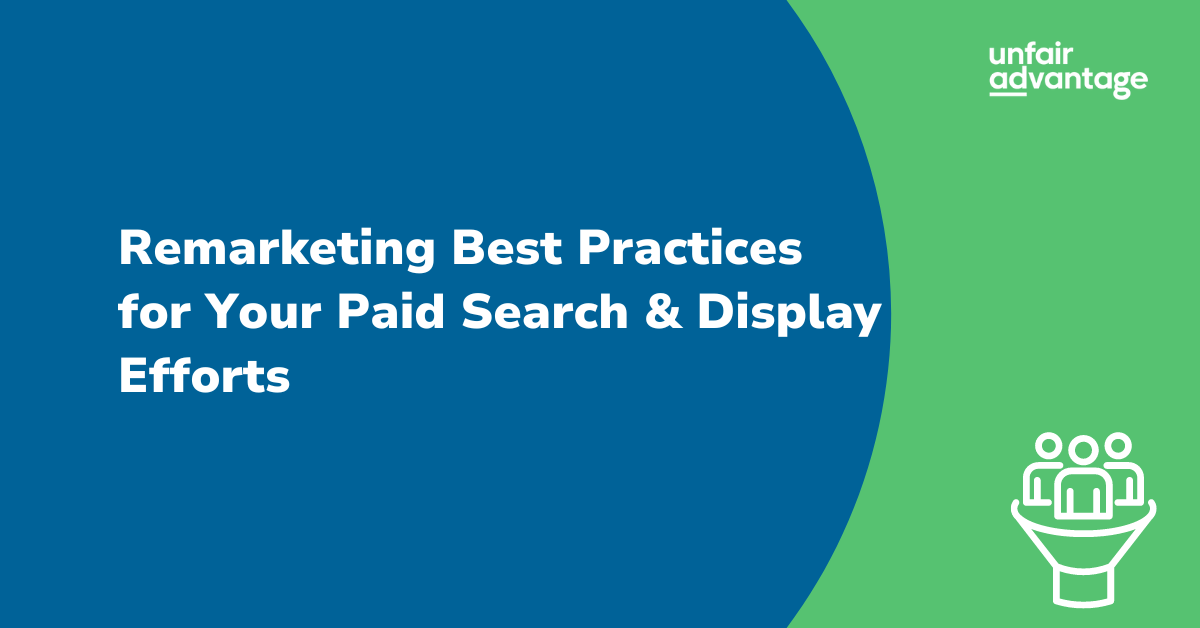
Remarketing Best Practices for Your Paid Search and Display Efforts
Remarketing is a powerful tool, enabling businesses to re-engage potential customers who have previously interacted with their website. This blog explores our tried and true best practices for implementing an effective remarketing strategy in your paid search and display efforts.
Remarketing involves targeting users who have visited your website but did not convert, aka the “window shoppers.” By showing these users tailored ads as they browse other websites or search engines, you can further encourage them to return and complete a desired action. We can refer back to the marketing funnel to showcase this:

Our window shoppers, living in the awareness funnel, often need multiple touches to be encouraged through the funnel. Remarketing allows us to give these users gentle nudges down and remain top of mind.
Best Practices for Paid Search Remarketing
-
Segment Your Audience
The first step is to segment your audience to ensure you can utilize this list in the future. This will allow you to create those personalized ads that resonate with different user groups. Keep in mind, these audience lists can take time to reach a usable member size so the sooner the better! Consider segmenting by:
- Pages visited – high value pages that relate to the end goal
- Time spent on site – user who have spent dedicated time on site are more value than user who may have only spent ~30 seconds
- Specific actions taken (e.g., adding to cart, download case studies, etc.)
-
Utilize RLSA (Remarketing Lists for Search Ads)
RLSA enables you to customize search ads and adjust bids for users who have previously visited your website. Use RLSA to:
- Increase bids for high-intent visitors
- Exclude irrelevant audiences
- Tailor ad copy to returning users
-
Set Up Conversion Tracking
Last but certainly most importantly, you will need to make sure you have implemented tracking. This will allow you to measure the effectiveness of your remarketing campaigns (ad copy, landing page, creative assets, etc.). Track metrics such as:
- Click-through rates (CTR)
- Conversion rates
- Cost per conversion
Best Practices for Display Remarketing
-
Use Dynamic Remarketing
A common trend, that we probably see the most often in e-commerce, is dynamic remarketing. Dynamic remarketing serves personalized ads featuring products (can be services too for you lead gen people!) that users viewed on your website. This approach can significantly increase relevancy and conversion rates as the product seemingly “follows you around”.
-
Frequency Capping
If you are worried about overwhelming users with too many ads, you can avoid this by setting a frequency cap. This limits the number of times an ad is shown to the same user, preventing ad fatigue or general annoyance.
-
Exclude Converted Users
Another thing to keep in mind is to ensure your marketing dollars are used effectively to ensure users who have already converted are excluded from your remarketing lists. This is key to ensure your ads are focused on non-converters. This helps in not only optimizing your budget but to also improving ROI.
Crafting Effective Remarketing Ads
-
Compelling Ad Copy
Ad copy will be key in your remarketing strategy. You want to focus on creating ad copy that directly addresses user pain points and offers a clear call to action (CTA). Some tips to keep in mind here:
- Highlight unique selling points
- Offer a discount

-
Visual Appeal
For your display strategy, on top of ad copy you will want to make sure your ads are visually appealing with high-quality images and consistent branding. Dynamic ads should display relevant product images to capture user interest.

-
Landing Page Relevance
Direct users to a relevant landing page that matches the ad’s message. Ensure the landing page is optimized for conversions with a clear CTA and easy navigation.
Monitoring and Optimization
Regularly monitor the performance of your remarketing campaigns and make data-driven adjustments. Analyze metrics such as:
- CTR and conversion rates
- Bounce rates
- User engagement
Use A/B testing to compare different ad variations and optimize for the best-performing creatives and strategies.

Conclusion
Implementing these best practices can help enhance your remarketing efforts, driving higher conversions and ROI. By segmenting your audience, using dynamic remarketing, and crafting compelling ads, you can effectively re-engage potential customers and boost your marketing performance.
Ready to elevate your digital marketing strategy? Contact us today to discover how our remarketing services can help you drive conversions and grow your business.

